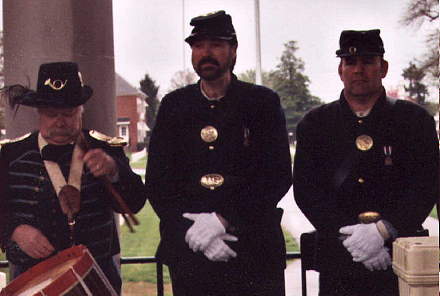
Members of Phelps Camp formed the Honor Guard for the catafalque. |
 |

Welcoming remarks by T. John Hilmer, Superintendent Wilson's Creek National Battlefield |
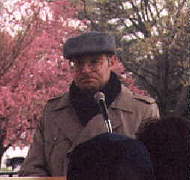
Invocation and Benediction by John C. Rutherford Past Dept. Commander, Dept of MO Sons of Union Veterans of the Civil War |
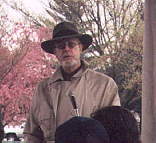
Dr. William Piston, Professor of History, SMSU, provided remarks. |
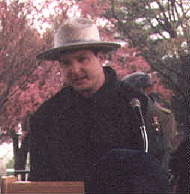
Michael Price, Phelps Camp 66 Commander, also addressed the gathering. |

Fran Black, Mary Whitney Phelps Tent 22, Daughters of Union Veterans of the Civil War. |

Robert Clanton, Past Camp Commander, presented the poem "When the Boys in Blue are Gone." |

The honor guard carrying the catafalque to the gravesite. |

One of the three volleys that comprised the twenty-one gun salute. |

Jeff Patrick (left) and Michael Price begin to unveil the monument. |
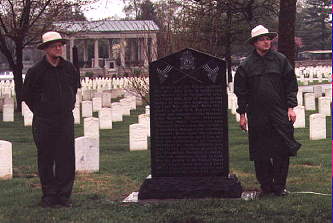
Jeff Patrick (left) and Michael Price flanking the newly-revealed monument. |
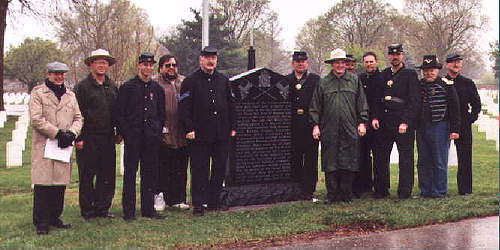 |
Some of the members of Phelps Camp 66,
Sons of Union Veterans of the Civil War |
Here is the text of an article which appeared in the Springfield, Missouri News-Leader, April 11, 2004. Story by Andrew Tangel, News-Leader staff.
To drumbeats and a gun salute, Union soldiers felled in the Battle of Wilson’s Creek were ceremonially buried in Springfield on Saturday, more than 142 years after they died in the Civil War.
“What do we owe these men who we’re about to give a final resting place today?” William Piston, a Southwest Missouri State University history professor, asked officials and enthusiasts assembled at Springfield National Cemetery, on East Seminole Street.
“We owe them honor, and I think we owe them a degree of sophistication.”
In addition to preserving battlefields and cemeteries, the professor urged serious study of history so that Americans “never let go of that past which is precious to all of us.”
Men dressed as Union troops carried the remains of an estimated seven men, kept in a small vault atop a ceremonial gurney, to a small plot among graves of soldiers who helped fight America’s wars.
Seven costumed soldiers -— members of the Phelps Camp No. 66, Sons of Union Veterans of the Civil War and Living History Volunteers -— fired muskets three times, the plumes of gunsmoke disappearing over the white tombstones.
On August 10, 1861 at Wilson’s Creek, the Union lost 285 of its ranks and an additional 186 were missing and presumed dead, Piston said. The Confederacy lost 277 men.
“The scale of the disaster really was great,” Piston said.
“Wilson’s Creek does not loom as large in our collective history as Gettysburg or Vicksburg or some of the larger battles, but for those who fought here, they had every reason to believe they were participating in something on an unprecedented scale.”
The skeletal fragments were unearthed in a sinkhole at Wilson’s Creek National Battlefield, near Republic, in the mid-1960s, said Jeff Patrick, librarian at Wilson’s Creek.
The approximately 200 bones, discovered by University of Missouri archeologists, remained in Columbia until officials sent them to an anthropologist in California for analysis a couple of years ago.
Patrick said park officials got the bones back about a year ago and timed Saturday’s burial ceremony with the dedication of a monument to Union soldiers.
The black marble stone had been placed near rows of Union graves at the cemetery.
Phelps Camp No. 66 members spent about five years raising more than $2,000 in donations for the monument, said member Robert Clanton.
“These were lives cut short. And it wasn’t just them. It was their families that paid a price, their friends,” said Carole Petty, a 58-year-old Springfield writer who attended.
“I’d like to think that we can learn from that, learn other ways to manage conflict, unlike what’s going on today.”
Petty said Saturday’s ceremony made history seem more real than do her duties as treasurer for the Civil War Round Table of the Ozarks.
“A lot of times I’m kind of involved with the paperwork, but I would rather be where you can feel what it’s all about,” she said. “And I can’t imagine those men, when they died, ever thought that a hundred-and-some years later somebody, somewhere, somehow would pay tribute to them.”
The vault was to be buried Saturday after visitors left, said Gary Edmondson, the cemetery’s director.
Return toPhelps Camp Homepage
Return to the Missouri Department Page.
This page hosted by

Get your own Free Home Page |
Meta tags provided by
Scrub the Web |